#Holy Roman Emperor Rudolph II
Text
Judaism and the Golem: Loyal Protector or Terrible Monster? - Historic Mysteries
Golems have always been fascinating. They have also been found throughout pop culture. Take "Batman: The Animated Series'.
Author’s Note: We’ve always found golems fascinating. There have been golems represented in pop culture. Such as in Batman: The Animated Series. (Which is one of the best Batman incarnations, by far. Our humble opinion, of course.)
https://www.historicmysteries.com/golem/
View On WordPress
#11th century#16th century#1883#Adam#Clay#Emet#Genizah#Ghetto#Golem#Golem of Prague#Holy Roman Emperor Rudolph II#Josef#Judaism#Middle Ages#Mysticism#Rabbinic Judaism#Sabbath#Sefer Yetzirah#Shem#Solomon ibn Gabirol#Talmud#Vltara River
1 note
·
View note
Text
Looking at the Austrian crown: 🥰😁😊😚😍
Drawing the Austrian crown: 😟☹️😥😢😰
Please someone save me, why did I do this to myself, look at this thing
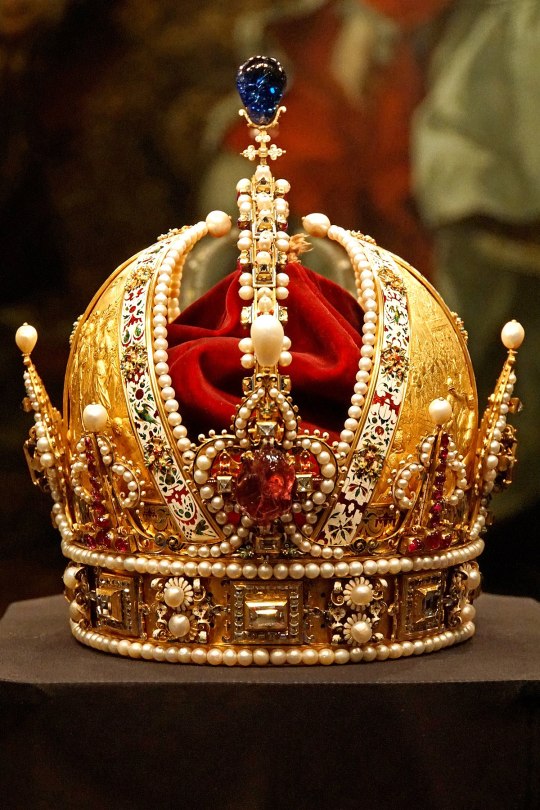
#catie: has never draw a crown in her life besides sketching and chibis#also catie: instantly decides to try to draw the most complicated one#im cursing you rudolph ii why did you have to be so tasteful#i still dont know tho if this is easier or harder than the holy roman empire crown#i think the general shape of the empire one is easier but the details are harder? idk honestly#and the crown im drawing is barely in any paintings UGHHHHH#even the professional painters looked at this and were like yeah nah im just putting that in the background#i don't wanna just give up and take it out of the painting bcs i think its cool#but idk if i can draw this 😭 its so complicated#its not even entirely historically accurate for seb to be wearing it#BIT I WANT HIM TOO SIB SOB SOB BCS IRS SO PRETTY#theres paintings of past emperors wearing the emperor crown so really i should be drawing that#but the austrian one is so much prettier 😭#so basically this crown was used as a personal crown by one emperor until the empire collapsed and then it became the imperial crown#so like techinally yeah seb shouldnt be wearing it bcs its for austria not the empire#but like cmon...in this au hes the type to wear a crown casually bcs bling bling yknow#but i am constantly cursed by historical accuracy#IDK WHAT TO DRAWWWWWWW#bcs i already drew the other austrian imperial stuff so i want the crown to match but ughhhhhh#catie.rambling.txt
12 notes
·
View notes
Text

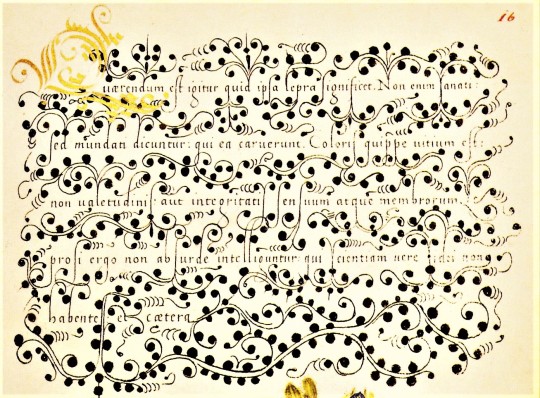

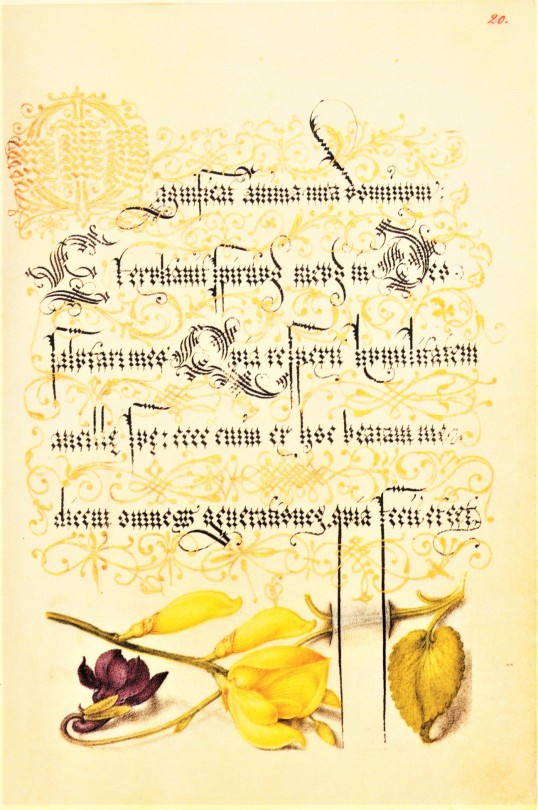









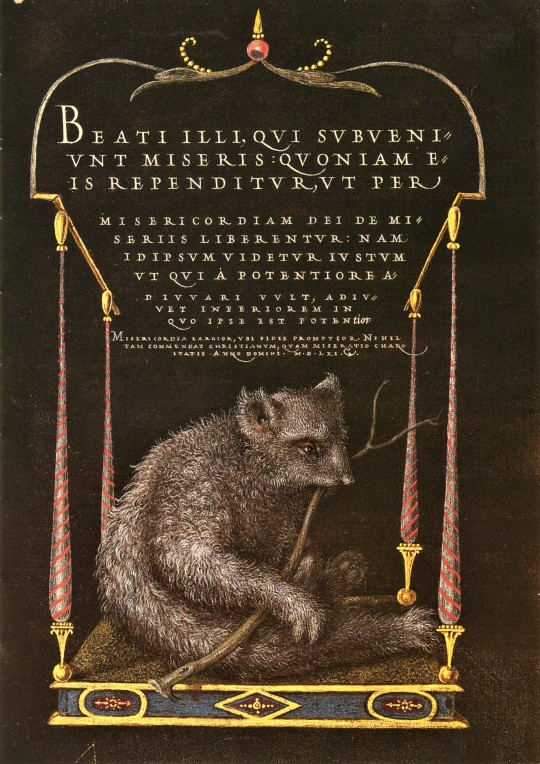
Typography Tuesday
We return to our facsimile of a 16th-cnetury calligraphic manuscript, Mira Calligraphiae Monumenta, or Model Book of Calligraphy, written in 1561/62 by Georg Bocskay, the Croatian-born court secretary to the Holy Roman Emperor Ferdinand I, and illuminated 30 years later by Flemish painter Joris Hoefnagel for the grandson of Ferdinand I, Emperor Rudolph II. The manuscript was produced by Bocskay in Vienna to demonstrate his technical mastery of the immense range of writing styles known to him. To complement and augment Bocskay's calligraphy, Hoefnagel added fruit, flowers, and insects to nearly every page, composing them so as to enhance the unity and balance of the page’s design. Although the two never met, the manuscript has an uncanny quality of collaboration about it.
Our facsimile was the first facsimile produced from the collection at the J. Paul Getty Museum in Los Angeles. It was printed in Lausanne, Switzerland by Imprimeries Reunies and published by Christopher Hudson in 1992.
View another post from Mira Calligraphiae Monumenta,
View more Typography Tuesday posts.
#Typography Tuesday#typetuesday#Mira Calligraphiae Monumenta#or Model Book of Calligraphy#Georg Bocskay#Joris Hoefnagel#illuminated manuscripts#manuscripts#manuscript facsimiles#facsimiles#calligraphy#letter forms#letters#J. Paul Getty Museum#Imprimeries Reunies#Christopher Hudson#Ferdinand I#Rudolph II
830 notes
·
View notes
Text
As an interest check:
Best Holy Roman Emperor:
Pros: Rerunning some of the contestants in this bracket, but also go back further and expand beyond the Habsburgs. Another chance for people to vote for Rudolph II's fruity...portrait.
Cons: Between us and @best-bourbon-monarch, we have probably already covered most of them.
Another German Dynasy:
Pros: We can include people who are also interesting in the same time period. The Saxons and the Bavarians have yet to appear, so it will open opportunities for more rp.
Cons: Admin 1 will have to do more reading and start a new blog, because they're primarily a Habsburg person.
Continue with a different tournament here:
Pros: This blog is already established and we could start immediately with something new after the final.
Cons: this is likely to be less interesting than the actual monarch bracket.
Napoleonic Sexyman Tournament:
Pros: This will be very fun and more than a little unhinged. I will get to ask you if Metternich is hot again. As someone specializing in the nineteenth century, this will be in admin 1's wheelhouse.
Cons: This will be unhinged
#this is an interest check for my own information#please tell me what you think#I'm having too much fun and I don't want it to stop
58 notes
·
View notes
Text
SAINT OF THE DAY (December 16)
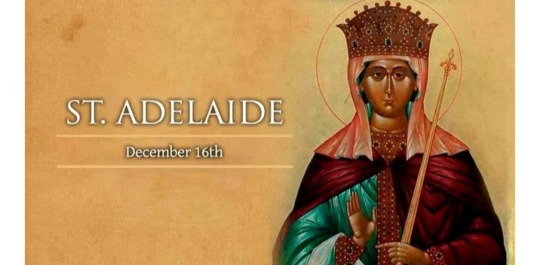
Born in 931 as the daughter of King Rudolph II of Burgundy, Adelaide was promised in marriage when she was only two years old to a man named Lothaire, the son and heir of his enemy, Hugh of Provence.
Lothaire was killed when still young, and Adelaide was to have a tumultuous life that paralleled the struggle for political power of the times, something she had come to symbolize.
She appealed to Otho the Great of Germany for help.
Having been sought after by various kings and nobles after Lothaire’s death, she was finally married by Otho the Great of Germany, who had invaded Italy.
After Otto’s death on 7 May 973, Adelaide exercised influence over her son Otto II until their estrangement in 978, when she left the court and lived in Burgundy with her brother King Conrad.
At Conrad’s urging, she became reconciled with her son. Before his death in 983, Otto appointed her his regent in Italy.
With her daughter-in-law, Empress Theophano, she upheld the right of her three-year-old grandson Otto III to the German throne.
She lived in Lombardy from 985 to 991, when she returned to Germany to serve as sole regent after Theophano’s death (991).
In 991, Adelaide was invested as the Regent of the Empire.
She used her power as the effective empress to increase evangelization efforts, especially in northern Europe.
She built many monasteries and churches, and also gave much aid the poor.
She governed until Otto III came of age in 994. When he became Holy Roman emperor in 996, she retired from court life, devoting herself to founding churches, monasteries, and convents.
She died in 999 at the monastery of Seltz, Alsace. She was canonized in 1097 by Pope Urban II.
4 notes
·
View notes
Text
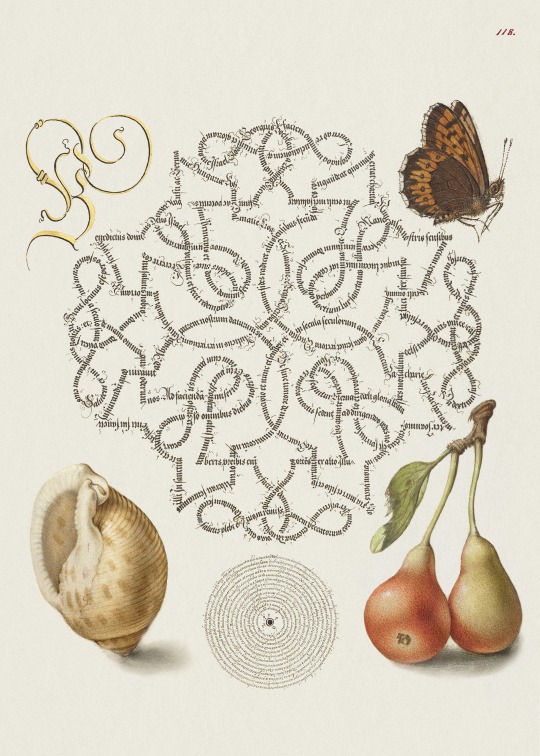


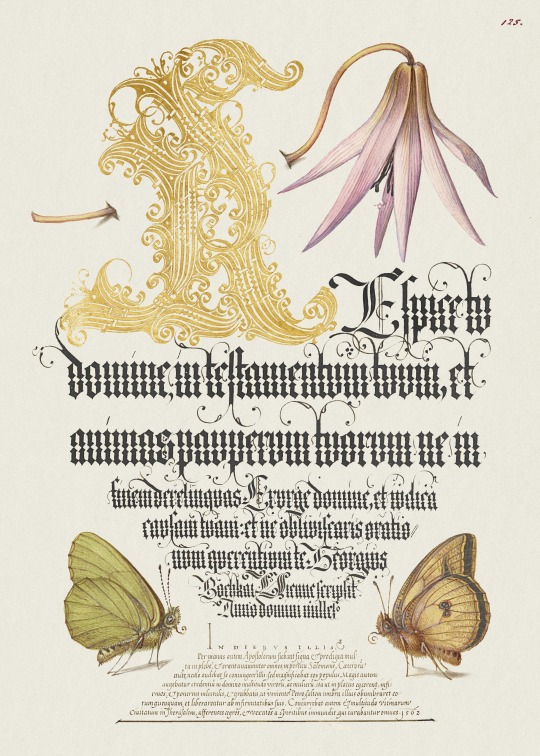



Mira Calligraphiae Monumenta: A 16th Century Calligraphic Manuscript Inscribed by Georg Bocskay & Illustrated by Joris Hoefnagel
Georg Bocskay, a master calligrapher & imperial secretary to the Holy Roman Emperor Ferdinand I, created Mira calligraphiae monumenta (Model Book of Calligraphy) as an exhibition piece. He assembled a vast selection of contemporary & historic scripts. Many of these selections were not intended for use, but for display. The manuscript demonstrated Bocskay's fine tuned calligraphy skills. Georg passed away in 1575, shortly after this book was written.
Around 30 years later, Emperor Rudolph II commissioned Europe's last great manuscript illuminator, Joris Hoefnagel, to embellish Bocskay's manuscript. In an attempt to out-do Georg's exemplary calligraphy work, Joris used every color, resource of illusionism, & form to devise brilliant grotesques - from flowers, fruits, insects, & animals to monsters & masks.
The end result is an incredible & unique collection of art & penmanship - "a landmark in the cultural debate between word & image."
#Georg bocskay#joris hoefnagel#calligraphy#mira calligraphiae monumenta#16 century art#16th century#model book of calligraphy
13 notes
·
View notes
Text
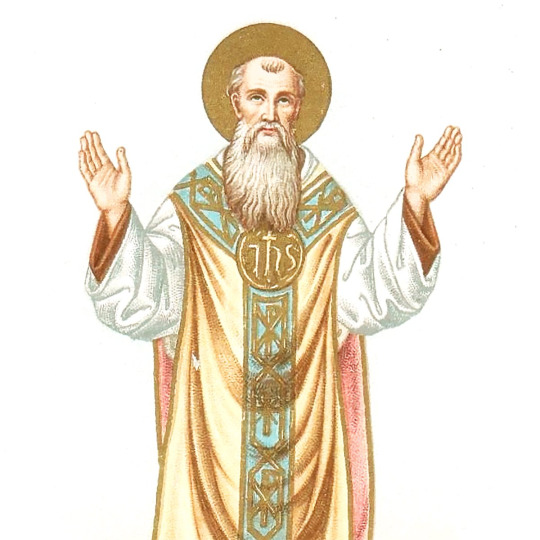
THE DESCRIPTION OF SAINT LAWRENCE OF BRINDISI
Feast Day: July 21
"Nos cum prole pia, benedicat Virgo Maria."
(Mary, with Her loving Son, bless us each and every one.)
One of the greatest preachers of the Order of Friars Minor Capuchin, Lawrence was born Giulio Cesare Russo, on the feast of St. Mary Magdalene - Brindisi, a city located in the Apulia region at Kingdom of Naples in the year 1559. Showing an early gift for oratory, he was always the one chosen to address, in accordance with the Italian custom, a short sermon to his compatriots on the Infant Jesus during the Christmas festivities. He is raised by a family of Venetian merchants. At the age of 16, he entered the Capuchin Franciscans in Venice, receiving the habit, and changed his name from Cesare to Lawrence.
An accomplished linguist, in addition to his native Italian, Lawrence could read and speak Latin, Hebrew, Greek, German, Bohemian, Spanish, and French fluently. While still a deacon he preached the Lenten sermons in Venice. After his ordination at the age of 23, he became famous throughout Europe as a forceful preacher. He also wrote many theological books and worked for the conversion of the Jews. Lawrence was elected superior of the Capuchin Franciscan province of Tuscany at the age of 31, and appointed definitor general in Rome for the Capuchins in 1596.
Pope Clement VIII assigned him the task of preaching to the Jews in the city. His knowledge of the Hebrew language was of great help in this regard. Beginning in 1599, Lawrence was sent to establish the Capuchin convents in modern Germany and Austria as a barrier agent in Lutheranism, furthering the Counter-Reformation and bringing many Protestants back to the Catholic faith. He also founded friaries in Vienna, Prague, and Graz.
On account of of his holiness, he was named the imperial chaplain of the Christian forces sent by Rudolph II (Rudolf II), Holy Roman Emperor, and successfully recruited Philippe Emmanuel, Duke of Mercœur, against the Ottoman Turks, who were threatening Hungary. Before the Siege of Székesfehérvár (Stuhlweissenburg) in 1601, though the Christians were outnumbered four to one, he gave a rousing address to the troops. Then he himself rode a horse before them, armed with the crucifix in his hand. The Turks were defeated and Europe was saved.
At their chapter of 1602, Lawrence was elected vicar general of the Capuchin friar, at that time the Order's highest office, whom he administered with energy and charity. Despite his fervent apostolate, Lawrence was a man of prayer and learning. He entered the service of the Holy See, becoming papal nuncio to Bavaria. After serving as nuncio to Spain, he retired to a monastery in 1618, and was recalled as a special envoy to the King of Spain regarding the actions of the Viceroy of Naples in 1619, and after finishing his mission, died in Lisbon, Portugal on July 22, 1619 - his 60th birthday.
Beatified by Pope Pius VI on June 1, 1783 and canonized a saint by Pope Leo XIII on the feast of the Immaculate Conception in 1881, Lawrence's remains were entombed at the Poor Clares' Convento de la Anunciada (Convent of the Annunciation) in Villafranca del Bierzo, Spain. Because of his creative yet orthodox writings on the Virgin Mary and for his commanding erudition in, and harmonious presentation of, Scripture, patristics, and fundamental theology, Pope St. John XXIII proclaimed him a Doctor of the Church in 1959.
Lawrence of Brindisi is the third Franciscan Doctor of the Church, along with Saints Bonaventure and Anthony of Padua, and, unfortunately, one of the least well-known.
0 notes
Text
Asteroids in astrology that is named after Kings and Queens, plus the meaning of the asteroids in astrology ✨👑
Credits to : wikipedia from google and other astrology websites because i didnt wrote this all
If you want to know what the asteroid means in astrology go to google and search the story of it. (Example : asteroid "hatshepsut (2436)" was named after the female pharoah hatshepsut from egypt, and then i checked her story and it was said that she was the greatest female pharoah of all time but receive jealousy from men because of her sucess , so then i interpret that into what the asteroid means in astrology, as simple as that)
(i will update and keep updating this post of I found some of the meanings of what the asteroid means is astrology)

12 Victoria (officially named after the Roman goddess of victory, but also honours Queen Victoria) - this asteroid also means victory in astrology so in astrology this asteroid symbolize "victory"
45 Eugenia (Empress Eugénie), with its moon Petit-Prince in part for her son Napoléon Eugène, Prince Imperial - displacement to the source of nourish, like migratory birds in nature
115 Thyra (Thyra, consort of King Gorm the Old of Denmark)
216 Kleopatra (Cleopatra VII of Egypt) - a femme fatale, amazing sex appeal, messy love life, having power over your lovers
220 Stephania (Princess Stéphanie of Belgium) - being in a unhealthy relationship and then break up and suddenly be in a healthy relationship with someone else
295 Theresia (Maria Theresa Walburga Amalia Christina Empress consort of the Holy Roman Empire and Queen consort of Germany)
326 Tamara (Queen Tamar of Georgia)
344 Desiderata (Queen Desideria of Sweden and Norway)
359 Georgia (King George II of Great Britain) -
392 Wilhelmina (Queen Wilhelmina of the Netherlands)
525 Adelaide (Queen Adelaide, consort of William IV of the United Kingdom)
545 Messalina (Messalina, Roman empress) - uncontrollable sexual desire or having nymphomaniac.
546 Herodias (Herodias, wife of Herod II and mother of Salome)
562 Salome (Salome, daughter of Herod II and Herodias) -
598 Octavia (Claudia Octavia, Roman empress)
650 Amalasuntha (Amalasuntha, queen of the Ostrogoths)
653 Berenike (Berenice II, Egyptian queen)
689 Zita (Empress Zita of Bourbon-Parma)
816 Juliana (Queen Juliana of the Netherlands)
823 Sisigambis (Sisygambis, mother of Darius III of Persia)
831 Stateira (Stateira, wife of Artaxerxes II of Persia)
832 Karin (Karin Månsdotter, wife of Eric XIV of Sweden)
888 Parysatis (Parysatis, wife of Darius II of Persia)
911 Agamemnon (Agamemnon)
1068 Nofretete (Nefertiti)
1128 Astrid (Astrid of Sweden)
2436 Hatshepsut (Pharaoh Hatshepsut)
3362 Khufu (Pharaoh Khufu)
4414 Sesostris (Greek version of Senusret, name of four pharaohs)
4415 Echnaton (Pharaoh Akhenaten; German spelling of his name)
4416 Ramses (Pharaoh Ramses II)
4568 Menkaure (Pharaoh Menkaure)
4721 Atahualpa (Atahuallpa)
4846 Tuthmosis (Thutmose, name of four pharaohs)
4847 Amenhotep (Pharaoh Amenhotep IV)
4848 Tutenchamun (Pharaoh Tutankhamun)
4906 Seneferu (Pharaoh Sneferu)
5009 Sethos (Greek version of Seti, name of two pharaohs)
5010 Amenemhet (Amenemhet, name of four pharaohs)
5242 Kenreimonin (Empress Dowager Kenrei)
7117 Claudius (Emperor Claudius)
7207 Hammurabi (Hammurabi)
7208 Ashurbanipal (Ashurbanipal)
7209 Cyrus (Cyrus II of Persia)
7210 Darius (Darius I of Persia)
7211 Xerxes (Xerxes I of Persia)
7212 Artaxerxes (Artaxerxes II of Persia)
8740 Václav (Václav I, Duke of Bohemia)
10293 Pribina (Pribina, ruler of Nitrian Principality)
11014 Svätopluk (Svätopluk, ruler of Great Moravia)
16951 Carolus Quartus (Charles IV, Holy Roman Emperor and King of Bohemia)
18349 Dafydd (Dafydd ap Llywelyn, prince of Wales)
20969 Samo (Samo, ruler of Samo's Empire)
25340 Segoves (Segoves, Celtic duke)
44613 Rudolf (Rudolph II, Holy Roman Emperor, king of Bohemia and Hungary)
48844 Belloves (Belloves, Celtic duke)
53285 Mojmír (Mojmír I, ruler of Great Moravia)
151834 Mongkut (King Mongkut, or Rama IV, the king of Siam)
326290 Akhenaten (Akhenaten, a pharaoh of the 18th Dynasty of Egypt) - forcing people that they don't like

#astrology#astro notes#astrology observations#astro observations#astrology notes#astro community#gemini#aquarius#libra#aries#queens#kings#royalties#astroblr#tarotblr#witchblr#astrology asteroid#astrology asteroids#asteroids astrology#asteroid astrology#asteroids in astrology#asteroid#asteroids#brielledoesastrology
244 notes
·
View notes
Text



Clockwork silver celestial globe crafted by Gerhard Emmoser for Holy Roman Emperor Rudolph II in 1579.
from the Metropolitan Museum of Art
382 notes
·
View notes
Photo

10 Adar II - The Maharal and the Emperor - 1592
On this day in 1592, the Maharal of Prague met with the Holy Roman Emperor Rudolph II. The Emperor had heard about the great Rabbi in his kingdom and of his expertise in the area of Jewish mysticism and kabbalah. Seeing as these were areas that interested the King, he invited the Rabbi to a meeting.
The meeting lasted for over an hour and a half in which many subjects of mysticism were discussed. The result was mutual respect developed by the two men for each other. This greatly benefited the Jewish community in Bohemia as the Maharal would often appeal to the king when issues of Anti-Semitism arose, and the king would respond in kind. This was during a general time of widespread Jewish persecution, but due to this relationship, the Jews enjoyed a nearly 20-year reprieve.
Rabbi Pinchas L. Landis
31 notes
·
View notes
Text
Codex Gigas Devil's Bible: Weird Medieval Manuscript - Historic Mysteries
Codex Gigas Devil’s Bible: Weird Medieval Manuscript – Historic Mysteries
https://www.historicmysteries.com/codex-gigas/
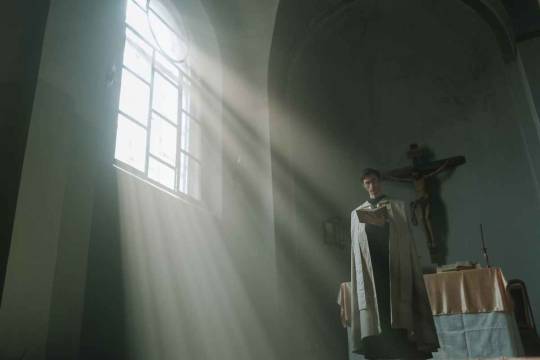
View On WordPress
#1295#13th century#16th century#7 May 1697#Benedictine Order of Břevno Monastery#Bohemia#Book of Revelation#Carolingian calligraphy#Codex Gigas#Czech Republic#Devil&039;s Bible#ermine loincloth#Giant Book#Heaven#Heavenly City#Herman the Recluse#Hermann Inclusus#Holy Roman Emperor Rudolph II#Incantations#Latin#Medieval#Middle Ages#monk#National Library of Sweden#New Jerusalem#Podlazice Monastery#Prague#Prince of Darkness#Satan#Sedlec
0 notes
Photo
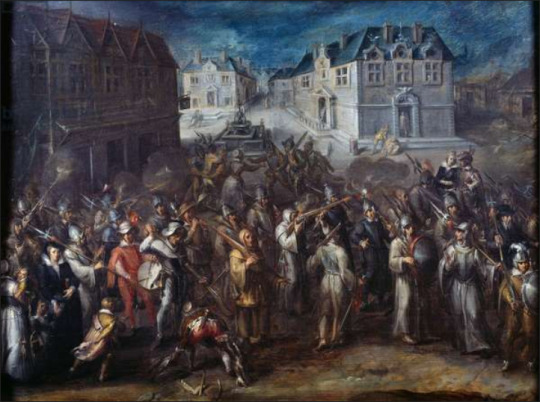
Joos van Winghe - Religious wars between Catholics and Protestants or Procession of the League in 1590 or 1593 -
Joos van Winghe, Jodocus a Winghe or Jodocus van Winghen (1544–1603) was a Flemish painter and print designer. He is known for his history paintings, portraits, allegories and genre scenes, including merry companies. He worked in Brussels as court painter and left Flanders after the Fall of Antwerp in 1584. He then worked in Frankfurt for the remainder of his career. In Germany he enjoyed the patronage of Holy Roman emperor Rudolf II and adopted a more clearly Mannerist style.
The principal source on the life of Joos van Winghe is the Flemish contemporary art historian and artist Karel van Mander. Modern art historians treat van Mander's biographies of artists with circumspection. Van Mander recounts that van Winghe was born in Brussels in 1544. There is no independent information which can confirm this birth date.
Van Mander states that van Winghe traveled to Italy to further his studies. In Rome he lived with a cardinal for four years. Van Winghe spent time in Parma where he reportedly painted a fresco of the Last Supper in the refectory of the monastery of the Servites. He worked in the workshop of the Italian Mannerist painter Jacopo Bertoja who also employed the Flemish painter Bartholomaeus Spranger. Bertoja took van Winghe and Spranger to paint in the rooms of the Villa Farnese that he had been commissioned to finish. He also worked in Rome and Parma for Bertoja. A close friendship between Spranger and van Winghe must have developed during their time in Italy. A drawing by Spranger after a painting van Winghe, which has disappeared today, proves that the two artists remained in contact decades later, when Spranger had been court painter to Rudolph II in Prague for many years and van Winghe had settled in Frankfurt.
On his return trip he passed by Paris. He spent time at Fontainebleau where he was exposed to the Mannerist style of the School of Fontainebleau. His period of travel is situated between 1564 and 1568. Flemish painter Hendrick de Clerck may have been van Winghe's pupil during his stay in Italy.
After his return to Brussels in 1568 he became court painter to Alexander Farnese, Duke of Parma, then the governor-general of the Spanish Netherlands. He created a number of religious compositions during his stay in Brussels. He married with Catharina van der Borcht, who was a member of the van der Borcht family of painters. Their son Jeremias van Winghe later became a painter. He left his home country with his family in 1584 after the Fall of Antwerp and his position as court painter was taken up by Otto van Veen. The fact that he left Flanders after the recapturing of Antwerp indicates that he was a Protestant. A painted allegory described by van Mander depicting a chained personification of Belgica, i.e. the Netherlands, supports the view that his emigration was politically motivated.
He settled in Frankfurt, where he became a citizen (burgher) in 1588. In Frankfurt he was part of the large contingent of Flemish artists who had left their home country for religious reasons, such as Hans Vredeman de Vries, Marten van Valckenborch and his sons Frederik van Valckenborch and Lucas van Valckenborch, Joris Hoefnagel and Jacob Hoefnagel. There were also a great number of Flemish printmakers in Frankfurt. Many of the artists were tied together through a network of family relationships established through intermarriage. The exiled artists regularly worked together on projects where each artist would contribute to a painting the portion in which they were specialised. For instance, a figure painter and still life painter would contribute respectively the figures and still life elements in a painting. The artists would also provide designs for the publications engraved by the Flemish printmakers established in Frankfurt. Van Winghe further maintained close relations with the group of Flemish artists in Frankenthal through Hendrik Gijsmans, with whom he was related by marriage, through his younger brother Maximilian van Winghe, who lived in Frankenthal and through his marriage to Catharina van der Borcht, which connected him with the painter family of van der Borcht. Van Winghe likely enjoyed the patronage of Holy Roman emperor Rudolf II thanks to his friend Spranger who was court painter. Spranger may have been instrumental in the purchase of van Winghe's painting Apelles paints Campaspe before Alexander for the imperial collection and a series of twelve apostles designed by him, which was dedicated to Archbishop Berka in Prague.
He was the father of the painter Jeremias van Winghe who remained active in Frankfurt.
He died in Frankfurt in 1603.
18 notes
·
View notes
Photo

Speckled Wood, Talewort, Garden Pea, and Lantern Plant, fol. 16 -
(papillon Bois moucheté, pois, bourrache et physalis)
Vienna, Austria (Place Created) 1561–1562; illumination added 1591–1596
Mira calligraphiae monumenta
Joris Hoefnagel (Flemish / Hungarian, 1542 - 1600)
and Georg Bocskay (Hungarian, died 1575)
Watercolors, gold and silver paint, and ink
Leaf: 16.6 × 12.4 cm (6 9/16 × 4 7/8 in.)
Getty museum Ms. 20 (86.MV.527)
In the 1500s, as printing became the most common method of producing books, intellectuals increasingly valued the inventiveness of scribes and the aesthetic qualities of writing. From 1561 to 1562, Georg Bocskay, the Croatian-born court secretary to the Holy Roman Emperor Ferdinand I, created this Model Book of Calligraphy in Vienna to demonstrate his technical mastery of the immense range of writing styles known to him.
About thirty years later, Emperor Rudolph II, Ferdinand's grandson, commissioned Joris Hoefnagel to illuminate Bocskay's model book. Hoefnagel added fruit, flowers, and insects to nearly every page, composing them so as to enhance the unity and balance of the page's design. It was one of the most unusual collaborations between scribe and painter in the history of manuscript illumination.
Because of Hoefnagel's interest in painting objects of nature, his detailed images complement Rudolph II's celebrated Kunstkammer, a cabinet of curiosities that contained bones, shells, fossils, and other natural specimens. Hoefnagel's careful images of nature also influenced the development of Netherlandish still life painting.
In addition to his fruit and flower illuminations, Hoefnagel added to the Model Book a section on constructing the letters of the alphabet in upper- and lowercase.
7 notes
·
View notes
Photo

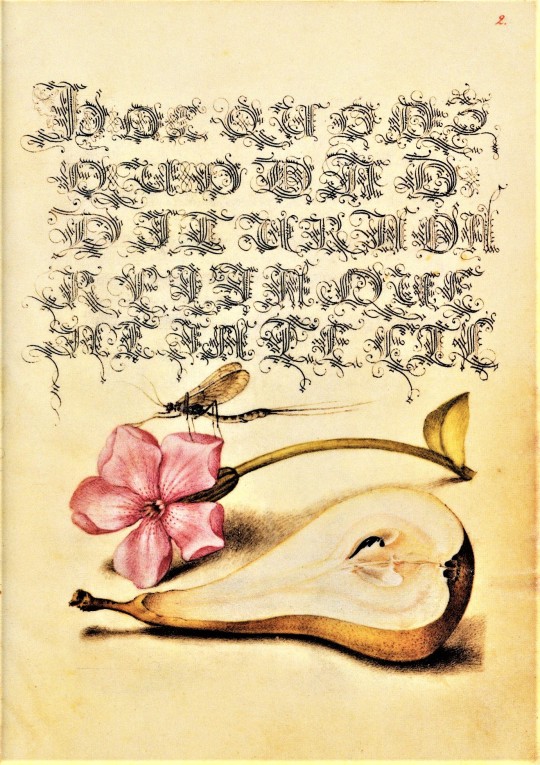
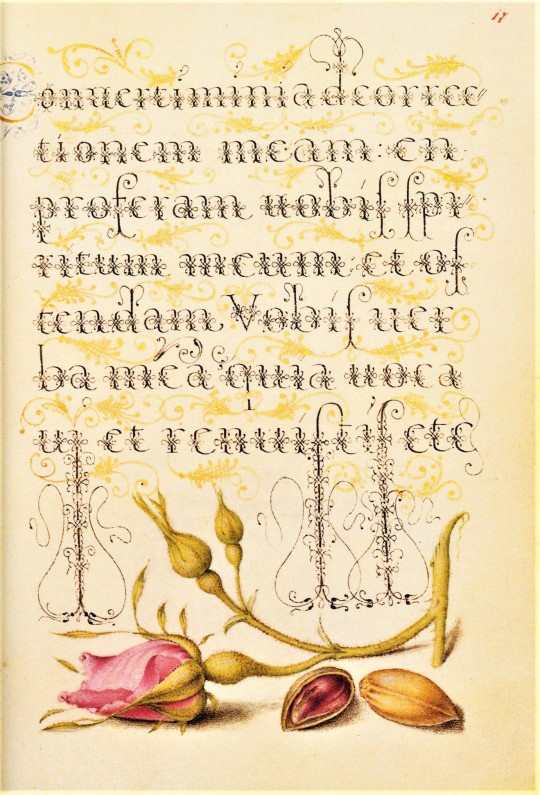




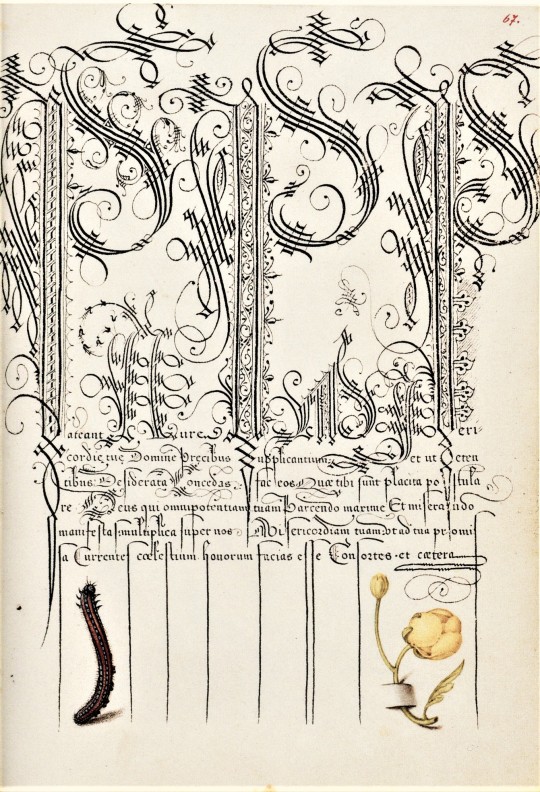


Typography Tuesday
Sometimes, things in our collection still surprise me, even after 29 years. From our fairly sizable manuscript facsimile collection, I was surprised I had never encountered this little (5 X 7 in.) reproduction of a 16th-cnetury calligraphic manuscript, Mira Calligraphiae Monumenta, the first facsimile produced from the collection at the J. Paul Getty Museum in Los Angeles, printed in Lausanne, Switzerland by Imprimeries Reunies and published by Christopher Hudson in 1992.
As the relatively new invention of printing came to dominate the production of books by the 1500s, the calligraphic inventiveness of scribes became prized for their aesthetic qualities rather than their production value.
From 1561 to 1562, Georg Bocskay, the Croatian-born court secretary to the Holy Roman Emperor Ferdinand I, created this Model Book of Calligraphy in Vienna to demonstrate his technical mastery of the immense range of writing styles known to him. About thirty years later, Emperor Rudolph II, Ferdinand's grandson, commissioned the [Flemish painter] Joris Hoefnagel to illuminate Bocskay's model book. Hoefnagel added fruit, flowers, and insects to nearly every page, composing them so as to enhance the unity and balance of the page's design. -- Getty Museum Collection webpage.
Although the two never met, the manuscript has an uncanny quality of collaboration about it.
Today we only show 11 pages from the facsimile, but we hope to present more from this highly-inventive manuscript of calligraphic virtuosity in the future.

View more Typography Tuesday posts.
-- MAX, Head, Special Collections
#Typography Tuesday#typetuesday#Typography Tuesday#Mira Calligraphiae Monumenta#Georg Bocskay#Joris Hoefnagel#calligraphy#letter forms#letters#J. Paul Getty Museum#Imprimeries Reunies#Christopher Hudson#illuminated manuscripts#facsimiles#manuscript facsimiles#Ferdinand I#Rudolph II
126 notes
·
View notes
Text

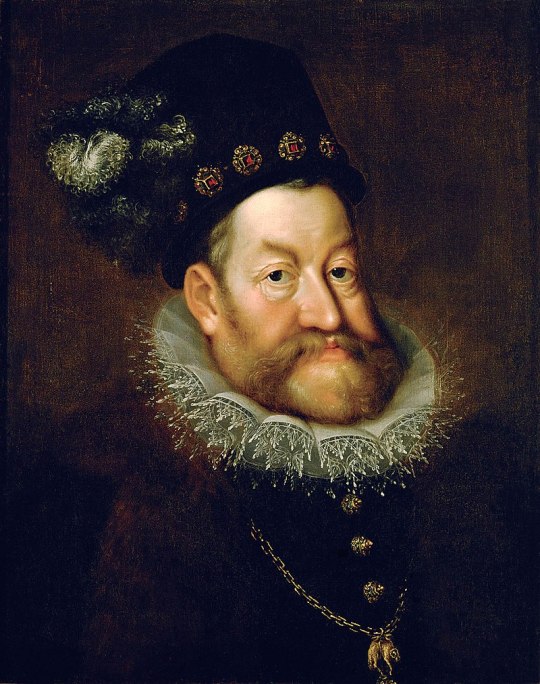
Franz Joseph, Emperor of Austria, reign: 1848-1916
- Now greyer than the previous polls
Rudolph II, Holy Roman Emperor, reign: 1576-1612
He wanted to be an alchemist not an emperor
Propaganda Under the cut for both:
For Franz Joseph:
By: @minetteskvareninova
- as much of a poor little meow meow as Joseph II
- also known as Starej Procházka (ask @archduchessofnowhere I promise it's hillarious)
- was there not for a good time, but a long time certainly, and unlike queen Victoria doesn't even get the dignity of an era named after him!!!
- wholesome friendship with Katharina Schratt
- girldad (better not ask about his son)
- loved the great god Mars, even though Mars did not love him back, wore uniform all the fucking time, but his actually military record was. well. gotta love a boyfailure.
- conservative in principle, but smart enough to know when to fold 'dem (which is why the former monarchy didn't end up like Russia)
By: anonymous
- Dual Monarchy. HELLO.
- Constitution! (Italy immediately declared war after but ya know)
- Survived assassination attempts
- Doesn't lose territory to Prussian unification which is something I guess
- Shares 2 names with Hayden
For Rudolph II:
- THE ABSOLUTE BICON 💗💜💙
- Contributions to art and science!!! Alchemy, astronomy, painting etc flourished in his court we literally have some of the most beautiful baroque artefacts because of him
- Where do you think that pretty little crown in the polls icon came from
- Would rather do that than politics so real king
- Accused of doing occult? He's THAT astrology witchblr bitch
- Mental illness girlies rep!!!
- Possibly neurodivergent girlies rep also!!
- VERY misunderstood and poor little meow meow uwu everyone thought he was incompetent and horny and cray cray like it was a bad thing
- We've voted on twinks? BEARS need love too!!! 💅
- Would've LOVED tumblr tbh he walked so all of us today could run 🩷🩷🩷
Fun fruit portrait:
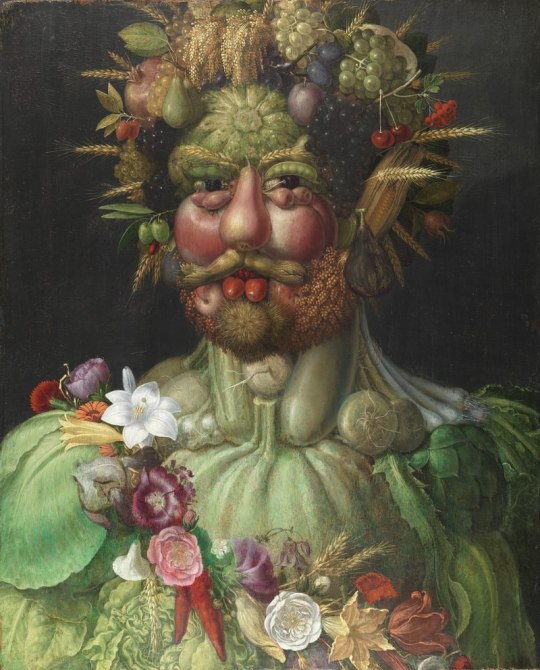
#best habsburg bracket#house of habsburg#franz joseph i#rudolph ii#congratulations to Franz Joseph for getting far enough for me to use his old man portrait
86 notes
·
View notes
Text
SAINT OF THE DAY (December 16)
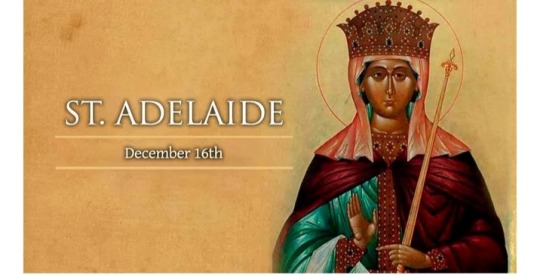
Adelaide was born in 931 in Burgundy, France, as the daughter of King Rudolph II of Burgundy, a member of the Elder House of Welf, and Bertha of Swabia.
She was promised in marriage when she was only two years old to a man named Lothaire, the son and heir of his enemy, Hugh of Provence.
Adelaide and her first husband had one daughter, Emma, born in 948 when Adelaide was only seventeen.
Lothaire was killed when still young, and Adelaide was to have a tumultuous life that paralleled the struggle for political power of the times, something she had come to symbolize. She appealed to Otho the Great of Germany for help.
Having been sought after by various kings and nobles after Lothaire’s death, she was finally married by Otho the Great of Germany, who had invaded Italy.
After Otto’s death on 7 May 973, Adelaide exercised influence over her son Otto II until their estrangement in 978, when she left the court and lived in Burgundy with her brother King Conrad.
At Conrad’s urging, she became reconciled with her son. Before his death in 983, Otto appointed her his regent in Italy.
With her daughter-in-law, Empress Theophano, she upheld the right of her three-year-old grandson, Otto III, to the German throne.
She lived in Lombardy from 985 to 991, when she returned to Germany to serve as sole regent after Theophano’s death (991).
In 991, Adelaide was invested as the Regent of the Empire. She used her power as the effective empress to increase evangelization efforts, especially in northern Europe.
She built many monasteries and churches, and also gave much aid the poor. She governed until Otto III came of age in 994.
When he became Holy Roman emperor in 996, she retired from court life, devoting herself to founding churches, monasteries and convents.
She died in 999 at the monastery of Seltz, Alsace. She was canonized in 1097 by Pope Urban II.
She is the patron saint of abuse victims, second marriages, step-parents, and widows.
Some of her relics rest in the reliquary chapel in the Basilica of the Sacred Heart on Notre Dame's campus.
3 notes
·
View notes